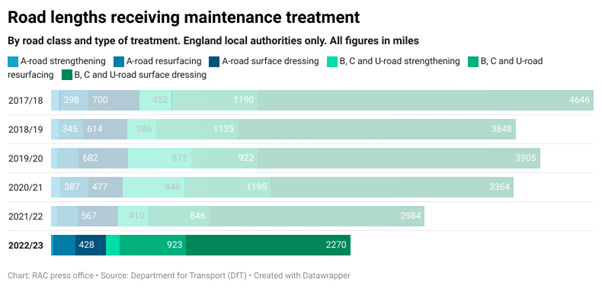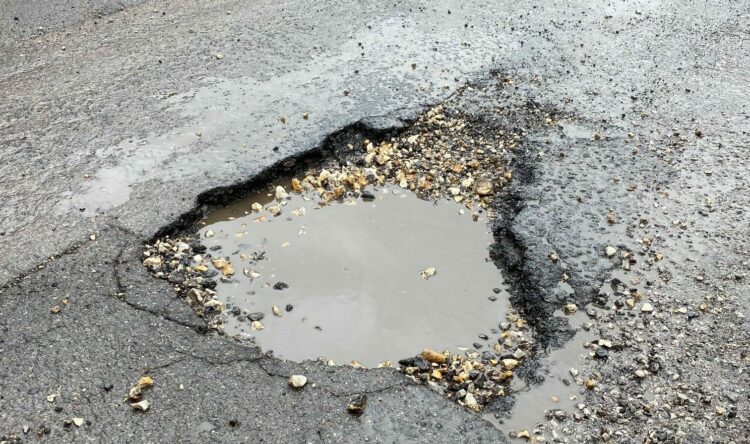Holes in government policy
Road maintenance hits a new low
Despite government statements over the last 12 months, our road network is getting worse.
Cancelling the continuation of the HS2 rail project was expected to lead to a revitalising of our road network.
In fact, road maintenance conducted by councils across England has fallen by almost half (45%) in 2022/23 compared to five years ago.
Holey mess
The latest statistics come from new analysis of Government statistics by the RAC.
This shows that the fall resulted in 3,366 fewer miles receiving any kind of improvement work in the last financial year.
It reveals that 764 miles of ‘A’ roads were strengthened, resurfaced or preserved during the 12 months. according to the report, it represents a 37% decrease (458 miles) from 1,222 in 2017/2018.
For minor roads listed as ‘B’, ‘C’, and unclassified, work was carried out on 3,380 miles of road in the past financial year compared to 6,288 five years before – a 46% (2,908 miles) drop.
Fleets are regularly having to deal with pothole-related damage to cars and vans. Just 4% of the 17,853 miles of A roads maintained by councils in England were resurfaced or given life-extending preservation treatment in 2022/23.
What’s more, cash strapped and bankrupt local authorities are having to pay increasing sums of compensation to motorists who’s cars have been damaged as a consequence of the lack of maintenance.
Naked truths
RAC head of policy Simon Williams says the figures “lay bare” the problems facing our road road network.
“We suspect this means road maintenance in England has reached a new low point – a sorry state of affairs considering how car-dependent the country is.
“It’s especially concerning to see that so few miles of A roads received any form of road maintenance last year when these important routes are used by millions of drivers every day.
“Meanwhile, our minor roads that are essential in connecting rural areas have received barely a crumb of the pie.”
Noting numbers
According to the official government statistics, 1,223 miles of all road types were entirely resurfaced by councils. While this is a small 9% increase on 2021/22, it down 22% on six years ago.
Meanwhile preservation treatments such as surface dressing and micro surfacing, which are used to extend the life of roads, fell to their lowest level in five years.
Just 2,698 miles of roads were given preservation treatment in the last financial year. This is a 50% drop on the 5,345 miles treated five years ago. Furthermore, it represents a 25% drop year-on-year compared to 2021/22.
Regionally, more than a third (35%) of the 158 roads authorities in the latest data failed to carry out any road surfacing. On top of this, six-in-10 (61%) carried out no preservation maintenance work at all.
Over the past 12 months, the average length of roads resurfaced for all authorities was just 17 miles and 28 miles for preservation work.
Regional rates
For two years running, Kent resurfaced the most miles of A roads. They resurfaced 26 miles of their 502 mile-network (5%), three miles less than the 29 it completed last year.
Meanwhile, Staffordshire carried out the most amount of preservation work – 36 miles of its 412 miles of A roads (9%).
Gloucestershire topped the tables for the highest number of minor roads resurfaced. It replaced 64 miles of its 3,066-mile network (just 2%).
Meanwhile, Norfolk completed the most preservation work by treating 251 miles of 5,573 roads (4.5%).
But the highest percentage of roads were treated in the West Midlands. Telford and Wrekin resurfaced 18% (nine miles) of its 52-mile network and Sandwell carried out preservation treatment on 13% (seven miles) of its 54-mile network.
Happy Christmas
These facts come after the RAC patrols attended the highest number of pothole related breakdowns over the Christmas period.
It also comes in the wake of the Government announcing its ‘biggest ever’ road resurfacing programme to improve local roads plagued by potholes.
The Department for Transport (DfT) allocated £8.3 billion of funds in November. This, it says, has been redirected from the cancelled phase 2 part of HS2. This is enough to resurface more than 5,000 miles of road across the country over the next 11 years.
However, the Asphalt Industry Alliance (AIA) has previously reported that more than 100,000 miles of the road network is in a serious state of disrepair. If not actioned soon, they could deteriorate to the point of needing to be rebuilt within the next 15 years.

Appy motoring
The RAC has partnered with technology company Metricell to encourage drivers to use Stan. This is a free mobile app that collects data on the state of UK roads and engages local authorities to fix the issues.
After downloading Stan, users can report a road defect by taking a photo or video with their smartphone.
The app uses AI to identify the defect which feeds into a national road map of surface issues on the RAC and Stan websites.







